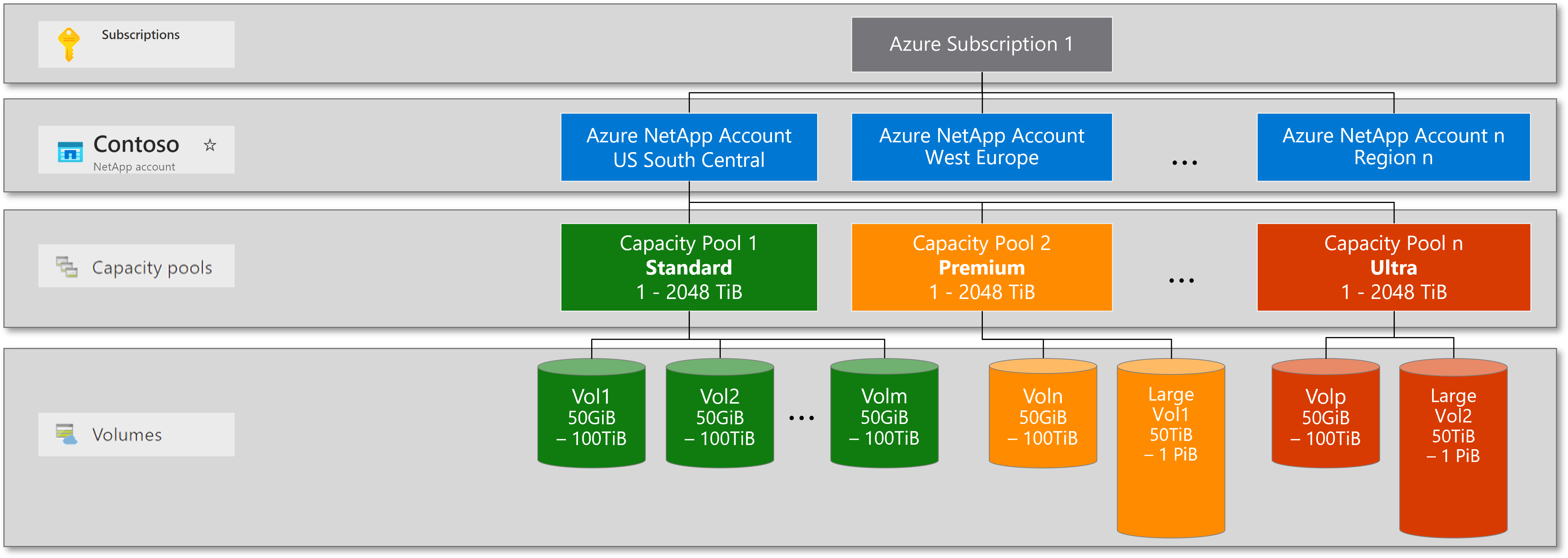Storage hierarchy of Azure NetApp Files
Before creating a volume in Azure NetApp Files, you must purchase and set up a pool for provisioned capacity. To set up a capacity pool, you must have a NetApp account. Understanding the storage hierarchy helps you set up and manage your Azure NetApp Files resources.
Important
Azure NetApp Files currently doesn't support resource migration between subscriptions.
Conceptual diagram of storage hierarchy
The following example shows the relationships of the Azure subscription, NetApp accounts, capacity pools, and volumes.
NetApp accounts
- A NetApp account serves as an administrative grouping of the constituent capacity pools.
- A NetApp account isn't the same as your general Azure storage account.
- A NetApp account is regional in scope.
- You can have multiple NetApp accounts in a region, but each NetApp account is tied to only a single region.
Capacity pools
Understanding how capacity pools work helps you select the right capacity pool types for your storage needs.
General rules of capacity pools
- A capacity pool is measured by its provisioned capacity.
For more information, see QoS types. - The capacity is provisioned by the fixed SKUs that you purchased (for example, a 4-TiB capacity).
- A capacity pool can have only one service level.
- Each capacity pool can belong to only one NetApp account. However, you can have multiple capacity pools within a NetApp account.
- You can't move a capacity pool across NetApp accounts.
For example, in the Conceptual diagram of storage hierarchy, you can't move Capacity Pool 1 US East NetApp account to US West 2 NetApp account. - You can't delete a capacity pool until you delete all volumes within the capacity pool.
- Azure NetApp Files storage with cool access is supported on Standard, Premium, and Ultra service-level capacity pool. For more information about service levels, including the Flexible service level, see Service levels for Azure NetApp Files.
Quality of Service (QoS) types for capacity pools
The QoS type is an attribute of a capacity pool. Azure NetApp Files provides two QoS types of capacity pools: auto (default) and manual.
Automatic (or auto) QoS type
When you create a capacity pool, the default QoS type is auto.
In an auto QoS capacity pool, throughput is assigned automatically to the volumes in the pool, proportional to the size quota assigned to the volumes.
The maximum throughput allocated to a volume depends on the service level of the capacity pool and the size quota of the volume. See Service levels for Azure NetApp Files for an example calculation.
For performance considerations about QoS types, see Performance considerations for Azure NetApp Files.
Manual QoS type
When you create a capacity pool, you can specify for the capacity pool to use the manual QoS type. You can also change an existing capacity pool to use the manual QoS type. Setting the capacity type to manual QoS is a permanent change. You can't convert a manual QoS type capacity pool to an auto QoS capacity pool. (However, you can move volumes from a manual QoS capacity pool to an auto QoS capacity pool. See Dynamically change the service level of a volume.)
In a manual QoS capacity pool, you can assign the capacity and throughput for a volume independently. For minimum and maximum throughput levels, see Resource limits for Azure NetApp Files. The total throughput of all volumes created with a manual QoS capacity pool is limited by the total throughput of the pool. It's determined by the combination of the pool size and the service-level throughput. For instance, a 4-TiB capacity pool with the Ultra service level has a total throughput capacity of 512 MiB/s (4 TiB x 128 MiB/s/TiB) available for the volumes.
Manual QoS capacity pools also support the Flexible service level, enabling you to adjust throughput and size limits independently for capacity pools using manual QoS. This service level is designed for demanding applications such as Oracle or SAP HANA. For throughput information, see Service levels for Azure NetApp Files.
Example of using manual QoS
When you use a manual QoS capacity pool with, for example, an SAP HANA system, an Oracle database, or other workloads requiring multiple volumes, the capacity pool can be used to create these application volumes. Each volume can provide the individual size and throughput to meet the application requirements. See Throughput limit examples of volumes in a manual QoS capacity pool for details about the benefits.
Volumes
- A volume is measured by logical capacity consumption and is scalable.
- A volume's capacity consumption counts against its pool's provisioned capacity.
- A volume’s throughput consumption counts against its pool’s available throughput. See Manual QoS type.
- Each volume belongs to only one pool, but a pool can contain multiple volumes.
- Volumes contain a capacity of between 50 GiB and 100 TiB. You can create a large volume with a size of between 50 and 1 PiB.
Large volumes
Azure NetApp Files allows you to create large volumes up to 1 PiB in size. Large volumes begin at a capacity of 50 TiB and scale up to 1 PiB. Regular Azure NetApp Files volumes are offered between 50 GiB and 102,400 GiB.
For more information, see Requirements and considerations for large volumes.
